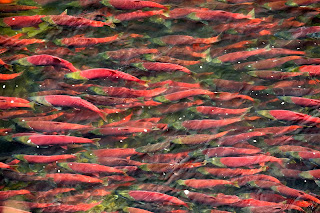I find it rather curious that the fight to create a large open pit mine, a large underground mine and the impoundment of billions of tons of mining waste behind several earthen dams is being proposed by Pebble Limited Partnership which is jointly owned by a company in the UK and Canada.
Proponents of the project are interested in the jobs the mine will create as well as the tax revenue for the state, but opponents are concerned with the impact on the entire Bristol Bay watershed and the risk to the downstream fisheries.
Proponents of the project are interested in the jobs the mine will create as well as the tax revenue for the state, but opponents are concerned with the impact on the entire Bristol Bay watershed and the risk to the downstream fisheries.
The Bristol Bay region in southwest Alaska is a pristine wilderness stretching from the rugged, snow-capped peaks of the Alaska Range across tundra and wetlands laced with rivers that flow into the bay, providing the best wild salmon habitat anywhere on Earth.
Tens of millions of salmon return to spawn in the bay’s drainages each year making it the richest commercial wild salmon fishery in the world. In addition to sockeye, the most abundant, there are King salmon plus trophy rainbow trout and the full array of Arctic wildlife from caribou to moose, wolves and grizzlies.
The watershed is home to many animal species, including 35 fishes, more than 190 birds, and more than 40 terrestrial animals. Probably most importantly the 32 million sockeye salmon and the $175 million that fishing industry brings to the area while supporting nearly 40% of the nation’s catch each year.
Pebble Limited Partnership is very much interested in the minerals buried within this region. According to 2010 estimates the area has 80 billion pounds of copper, over 100 million ounces of gold and 5.6 billion pounds of molybdenum, which is used in the manufacturing of metal. The total market value of the minerals is in the neighborhood of $500 billion. Due to the ownership structure, most of the profits would flow out of state.
In May, 2010, nine federally-recognized tribes and other concerned parties formally requested that the EPA to use the Clean Water Act to prevent the construction of the mines. The EPA is currently working on an assessment to determine the significance of Bristol Bay’s ecological resources and to evaluate potential impacts of large-scale mining on these resources. The EPA is in the process of reviewing feedback and intends to issue a final assessment yet this year.



No comments:
Post a Comment